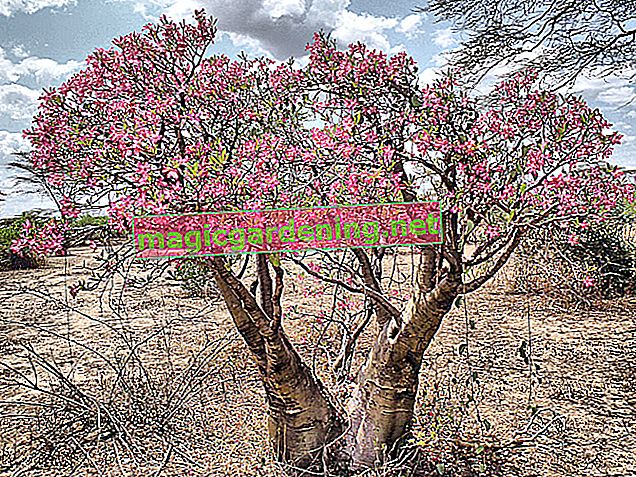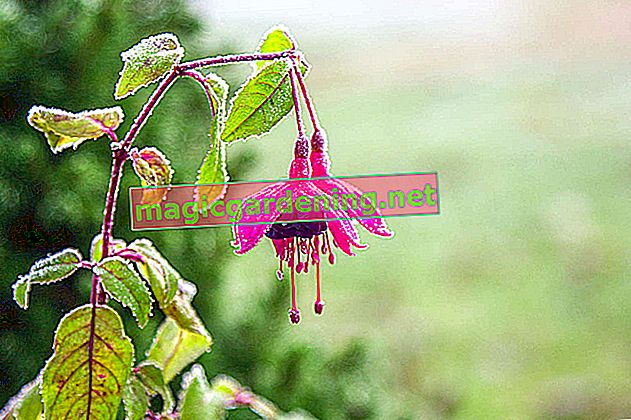
The right type of cut for every objective - table with dates
Lavish blooms, shapely growth, long lifespan and rejuvenation - the good-natured cut tolerance of summer lilacs fulfills almost every request of the gardener. The following table summarizes all types of cuts with the best dates:
also read
- Yellow leaves on buddleia - causes and measures
- Buddleia requires the greatest possible planting distance
- Summer Lilac Growth Per Year - How Big Does It Get?
| Cut type | Goal setting | meeting |
|---|---|---|
| Body section | build a stable framework | in the spring of the first 3 to 4 standing years |
| Conservation cut | optimal abundance of flowers, long life, beautiful shrub shape | Mid-February to early March |
| Flower care | long flowering period | several times during the summer |
| Taper cut | Revitalize aged buddleia | Late winter until March 1st |
| Pruning care for panicles and buddleia | Preservation of summer abundance of flowers | Mid-February to early March and after the flowering period |
| Upbringing high trunks (common buddleia) | Structure to a round-crowned, flower-rich tall trunk | Mid-February to early March and after the flowering period |
Only cut Buddleia when it is not freezing and the branches are not in direct sunlight. Other garden shrubs can be pruned down to -5 degrees Celsius. The brittle wood of butterfly lilac, on the other hand, should be cut at temperatures above freezing point. Rain-damp weather is an obstacle to flower care, especially in summer. Wet wood impairs wound healing and serves as the perfect gateway for diseases or pests. If necessary, postpone the maintenance cut to a later date with dry and overcast weather.
background
Think of the animal world when you cut it
The recommended dates for the pruning of Buddleia do not have growth-related reasons alone. Far-reaching measures such as conservation and rejuvenation pruning are regulated by law to protect breeding birds. The Federal Nature Conservation Act states that between March 1st and November 30th, only cuts in this year's growth and for flower care are allowed. Thinning out, sitting on the stick and similar radical cuts are to be carried out outside the grace period. Regardless of when a shrub or tree is pruned, it must be ensured that wild animals are in no way disturbed by the measure.Build up Buddleia with a stable framework
A stable framework favors the harmonious structure of your summer lilac. In the first three to four years you should therefore pay special attention to the strongest three to five ground shoots , as illustrated below. How to perform the perfect body cut:
- In the first year of standing, select 3 to 5 ground shoots as a framework and cut back to 30 centimeters
- Cut off all remaining ground shoots at the base
- Extend the scaffold drives annually by 15 to 20 centimeters between the second and fourth years
- Shorten the side shoots on the frame to cones with 1 to 2 pairs of eyes
By default, the frost hardiness of buddleia decreases noticeably with increasing age of its ground shoots. For this reason, start with a continuous rejuvenation in the shrub structure in the fourth year . Choose a promising annual ground shoot, shorten it to 30 centimeters and remove the weakest scaffold shoot from the initial phase.
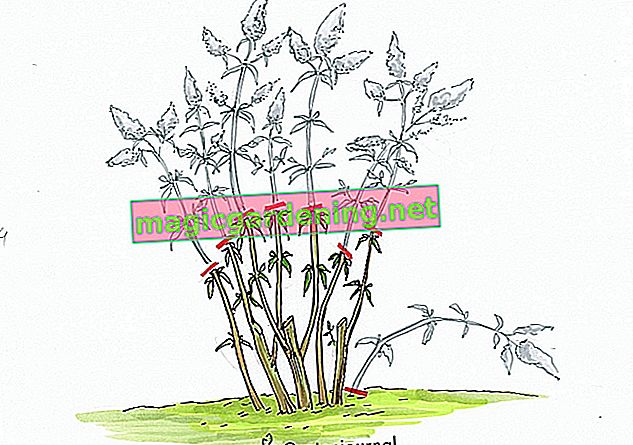
Tips
If you plant summer lilacs as bare-root goods, initiate the formation of a stable framework with a plant cut. To do this, cut all shoots by half after planting or between November and March. By placing the scissors just above a pair of eyes, you favor the subsequent budding.
Strong maintenance cut promotes pompous abundance of flowers
A buddleia sprouts long branches in spring and blooms on them in summer. Accordingly, no valuable buds can fall victim to pruning. On the contrary, the number and size of flower panicles increase the more you cut away from the faded wood from the previous year. Following the construction cut, the maintenance of the cut continues as follows:
- Cut back the ground shoots belonging to the framework by half, or at least to 100 cm
- From the fourth year on, shorten the oldest ground shoot to 10 cm
- As a substitute, cut a young, strong ground shoot to a height of 30 cm
- Radically prune all withered side branches from the previous year to 2 to 4 buds
There is no need to worry if a framework of short ground shoots with even shorter branch stumps remains from the cut summer lilac, as shown in the figure below. The annual exchange of young for old among the scaffolding shoots serves to continuously rejuvenate and effectively prevents premature aging.
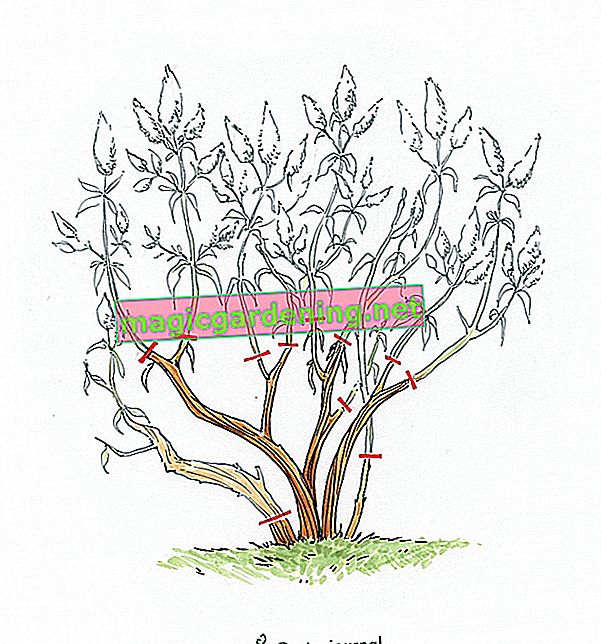
Digression
Moderate pruning prevents bulky habit
The rigorous pruning of the buddleia is a double-edged sword. If you cut down to short stumps, you will achieve the optimum in terms of abundance of flowers. However, sparse, unattractive growth and the formation of unsightly knots are to be expected. By taking a more moderate approach to the cut, you will give your butterfly lilac a more appealing silhouette. Ideally, you should vary the cutting heights, shortening well-placed shoots by a third. Only the branches that interfere with the overall picture are cut back as vigorously as the instructions for maintenance pruning recommend.Consistently remove what has faded
If the majestic panicles of flowers withered in midsummer, more buds are waiting on the side shoots. So that a buddleia does not invest energy in the formation of capsule fruits, clean out withered inflorescences. Cut the faded panicles back to the nearest side shoot . If you continue to care for the flowers regularly, the ornamental wood will keep its picturesque flower dress into autumn.
Continuous cleaning prevents unwanted self-sowing, which has earned the reputation of an invasive plant in some regions. As a precaution, do not dispose of withered flowers on the compost so that the wind does not scatter the seeds around the garden.
Rejuvenation thwarts old age - this is how it works
If the gardener misses the regular replacement of outdated scaffolding shoots, summer lilac will grow old in no time at all. The shrub turns into a dense undergrowth of sparsely blooming branches and twigs. The floral tragedy is not a reason for clearing. Thanks to the cut tolerance and budding force, you can rejuvenate the flowering shrub. How to do it right:
- The best time is in late winter until March 1st
- Clear out all dead wood in advance
- Ideally, derive aged ground shoots from a young side shoot in the lower area
- Cut the young side shoot back to 30 cm as the new main shoot
- Shorten shoots in the soil to 30 cm
- Cut the remaining side branches on stumps with 2 eyes
If there are no offspring ground shoots, the prognosis for a new growth worsens. You give the unwilling shrub a generous amount of fertilizer under the arms. Spread 3 liters of ripe compost and 100 grams of horn shavings per square meter of root disc surface. (€ 6.39 at Amazon *) Rake in the organic fertilizer on the surface and pour in. If the supplementary supply of nutrients does not result in the growth of fresh ground shoots by next year, the buddleia is exhausted and should be cleared.
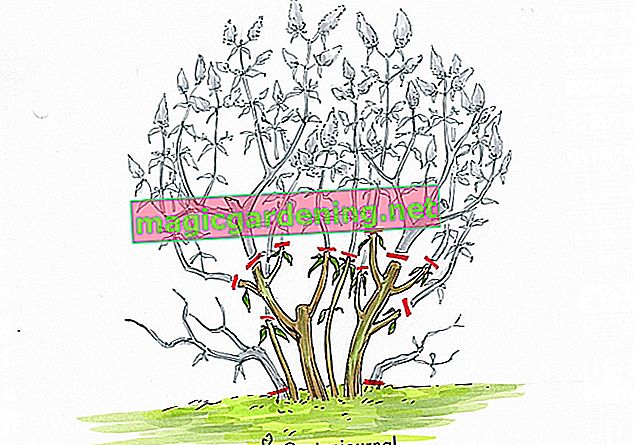
background
Taper cut brings sleeping eyes to life
Gardeners refer to dormant bud systems as sleeping eyes. Their only function is to ensure further growth as a reserve in the event of failure of parts of the plant. A sleeping eye is located below the bark and is usually not visible. Sometimes you can feel the dormant bud as a slight thickening. A rejuvenating cut is considered an emergency case for the Buddleia to activate its sleeping eyes. The entire sap pressure is concentrated on the inactive bud systems, so that they sprout as a branch or leaf.Be careful when pruning the common buddleia
Summer lavender (Buddleja alternifolia) differs in several ways from the common buddleia (Buddleja davidii). Long, arching, overhanging side branches form on its upright main shoots. The flowers appear in clusters from June to July. It is significant for the cut that the common buddleia blooms on the previous year's and old wood . This results in a completely different pruning than on common buddleia. You should pay attention to this when cutting:
- Do not cut the common buddleia in the first few years
- Thinning out dead ground shoots and twigs in late winter
- Strongly overhanging shoot tips after flowering lead to a lower side shoot
- Cut back weak, arching side branches to a short pin on the scaffold shoot
A moderate exchange of the ground-borne main shoots for young ground shoots is beneficial for vitality and willingness to flower. If the number of flower clusters decreases over the years, cut off one or two of the oldest ground shoots at the roots. In contrast to common buddleia, pruning is only necessary when necessary and not every year.

Tips
An overaged summer lavender is rejuvenated more carefully than a butterfly lilac. Since it hardly bears any flower buds anyway, cut off half of the aged ground shoots at their roots between mid-February and early March. You can slim down the remaining ground shoots by making a derivation cut on the most promising side branch in the lower area.
Raising summer lilacs to become tall trunks - this is how it works
The combination of growth characteristics and pruning tolerance recommend hanging summer lilacs for raising a tall trunk. The goal is a round crown made up of four to five main branches , on which the hanging flower branches are in the limelight. In contrast to the picturesque counterpart in a majestic shrub shape, annual pruning is required for upbringing and maintenance . How to proceed professionally:
- Guide the central drive up the support rod to the desired height
- Cut off competing ground shoots and all side shoots at the base
- The top of the stem cuts off 4 to 6 pairs of buds or leaves above the desired crown height
With the cut of the trunk tip you initiate the branching to a crown with at least 4 leading branches. You train the leading branches to a length of 50 to 60 centimeters so that the elegant, drooping flower branches develop on them. After the flowering period, shorten the faded side branches to short stubs on the respective main branch. Stay on the heels of cheeky competitive instincts with the scissors and cut them off promptly and at the base. Proceed in the same way with all shoots along the trunk that do not belong to the crown.
background
Observing the growth law top funding pays off
The upbringing cut to the tall trunk stands or falls with the cut of the central shoot for crown formation. Finding the perfect time is no longer a mystery, even for beginners, if they are familiar with the growth law of top funding. In every plant, the top bud is the hotspot. With maximum juice pressure, reserve substances flow to it. Hence, this is where the growth is greatest. Lower-lying types of buds are given less priority for nutrients. As soon as the top bud is removed, the previously subordinate buds benefit from the excess juice. Then bud to form a beautiful crown. Conversely, the law of growth means: premature cutting of the tip of the central shoot prevents growth to the desired stem height.Important data for cutting care in a nutshell
After reading this tutorial, you will be familiar with all types of cuts and possible stumbling blocks in the maintenance of cuts. If you still have doubts about the correct procedure while working on the shrub, consider the following data on common buddleia and summer lavender:
- Growth: deciduous shrub
- Origin: subtropical and tropical regions
- Growth height: 200 to 300 cm (dwarf varieties: 60 to 80 cm)
- Spread: 150 to 250 cm (dwarf varieties: 50 to 60 cm)
- Name of the most popular species: Buddleia, Butterfly Lilac (Buddleja davidii)
- Name of another species: Summer lavender, panicle summer lavender (Buddleja alternifolia)
- Flowering period Buddleia: July to November
- Flowering period: Summer lilacs: June and July
- Plant of the buddleia flowers: on this year's fresh wood
- Plant of the buds buddleia flowers: on previous year's and perennial wood
- Time to cut the Buddleia: every spring (flower care in summer)
- Time to cut the common buddleia: in February if necessary (flower care in summer)
- Toxic content: slightly toxic
- Winter hardiness: good, decreasing with age
frequently asked Questions
Which loppers are better suited for buddleia, bypass or anvil shears?
Buddleia thrives with a distinctly brittle wood. We recommend scissors with a bypass mechanism so that it does not splinter during the cut and create unnecessarily large cuts. Such models work with two sharp blades that run against each other and leave smooth cuts. Anvil shears have a sharp and a blunt side, which can lead to bruises in the stubborn wood. Use one-handed secateurs to cut shoots up to 2 centimeters in diameter. Two-hand pruning shears are suitable for branches up to 4 centimeters thick. A sword saw should only make the cut from a branch diameter of 4 centimeters or more.
Our buddleia collapses under the snow load every winter. How can we prevent the snow break?
An annual, strong pruning to promote the abundance of flowers is at the expense of stability. The dense branching alone is not enough to cushion the snow pressure on the leafless buddleia. The ornamental wood is supported if you loosely tie all the branches together with sisal cord or coconut cord before the start of winter. If your garden is in a particularly snowy region, attach the cord to a wooden post so that the shrub does not have to carry the white burden on its own.
Is Buddleia Poisonous?
Buddleia species and varieties are classified as slightly poisonous. Skin contact with plant parts or plant sap is harmless. It is not advisable to consume flowers, leaves and capsule fruits. Aside from the horrible taste, this way poisonous glycosides and saponins get into the stomach, which cause nausea and vomiting.
We want to transplant our 10 year old buddleia in autumn. Does the measure influence the cut?
The change in location is inevitably associated with the loss of root mass for your buddleia. There is an imbalance between subsurface and aboveground growth. You can restore the balance by pruning immediately after transplanting. If you waited until the regular appointment in spring, the shrub would have already suffered damage because the few roots can no longer supply all of the shoots.
I regularly cut off the withered flower panicles on my butterfly lilac. How should you proceed with the common summer lilac because it should not be cut or cut little?
You can also safely cut off withered flower clusters on the hanging summer lilac. However, you must not hope for a continuation of the flowering period afterwards, as with the common summer lilac. It is important to note that you clean off everything that has withered immediately after the flowering period and do not cut too deep. Depending on the local framework conditions, the buds for the next year have already been created and are inadvertently carried away by the scissors.
My 3-year-old summer lavender has only 2 ground shoots with a few side branches. Nothing grows back in the lower area, although I fertilize diligently. What should be done to make the shrub grow stronger?
You can regulate the disappointing growth of summer lilacs with a strong pruning. In this way, the flowering shrub can rebuild itself with bushy growth. Shorten the two ground shoots by at least half. Cut the side branches on it back to short stubs with two eyes. This summer the shrub will not bloom. You can only look forward to flowers again in the following year.
I would like to integrate buddleia into a mixed hedge that will serve as a privacy screen. What do you think of the idea?
The most beautiful summer lilac varieties grow funnel-shaped and form a privacy screen from around 120 centimeters during the leafy season. In the lower shrub area, it is advisable to plant additional privacy protection. For example, the petite Deutzia (Deutzia gracilis) with a height of around 60 centimeters is well suited as underplanting. For a patient gardener, one summer lilac bush per meter is enough. The privacy screen is available more quickly if you plant two plants per meter. In spring the bushes are cut back to 50 centimeters.
At the beginning of April I planted two Buddleia, which sprouted immediately. As a result of the last frosty nights, all the leaves are now hanging limp and withered on the shoots. Should I cut back now or wait for the next budding?
Please wait until mid / end of May. By this time, regrowth has started and you can see how far your buddleia has frozen back. If you are unsure where the transition from dead to healthy wood is at the shoot, scratch a little bit of the bark with your fingernail. Where brown, dry tissue is visible, it is dead wood. Light, green-yellow and juicy tissue is vital and will continue to grow. You can use the scissors there.
The 3 most common mistakes
If the flowering period on the Buddleia comes to an end prematurely, the shoots grow old or the flowering period completely fails on the panicle Buddleia, the shortcoming is due to a neglect in the pruning. The following table summarizes the three most common cutting errors with tips for effective prevention:
| Cutting errors | Damage | prevention |
|---|---|---|
| withered flowers not trimmed | premature end of the flowering period | Cut off faded panicles regularly |
| never exposed | Scaffold drives age after a few years | Thinning out dead wood, continuously growing young ground shoots as a substitute for outdated scaffolding shoots |
| Summer lilacs cut like common buddleia | Failure of this year's heyday | just thin out and replace old ground shoots with young ones |
Tips
Home gardeners often have to complain about powdery mildew infestation on their buddleia. Warm and humid summer weather increases the risk of infection significantly. Furthermore, unclean cutting tools often transmit the fungus pathogens in spring. If a mealy-gray-white coating spreads on the leaves, please use the scissors immediately. Cut off all affected shoots. Then treat the sick butterfly lilac with a spray solution of one liter of water and one eighth liter of fresh milk.

